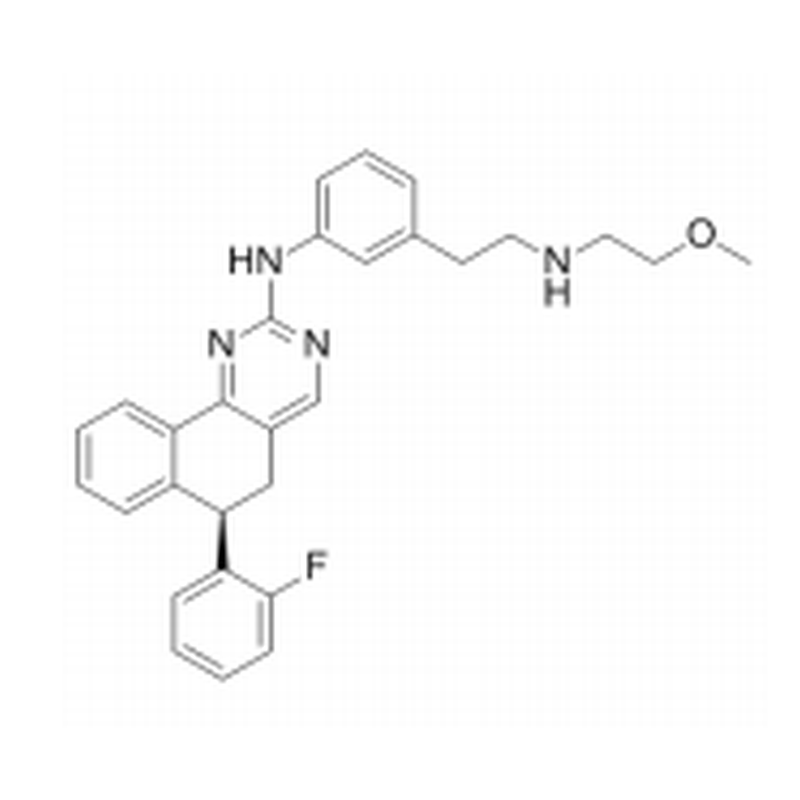产品
编 号:F084992
分子式:C29H29FN4O
分子量:468.57
分子式:C29H29FN4O
分子量:468.57
产品类型
规格
价格
是否有货
10mM*1mL in DMSO
询价
询价
1mg
询价
询价
5mg
询价
询价
10mg
询价
询价
25mg
询价
询价
50mg
询价
询价
结构图

CAS No: 1234356-69-4
产品详情
生物活性:
Derazantinib (ARQ-087) is an ATP competitive and orally activeFGFR inhibitor (IC50s: 1.8 nM for FGFR2, 4.5 nM for FGFR1 and 3 nM). Derazantinib inhibits FGFR phosphorylation. Derazantinib inhibits tumor growth in multiple xenograft models.
体内研究:
Derazantinib is effective at inhibiting tumor growth in FGFR2 altered, SNU-16 and NCI-H716, xenograft tumor models with gene amplifications and fusions. Most of the embryos exhibit abnormal external phenotype (81.3%) in Derazantinib-injected wings, possibly due to inhibition of proliferation of limb bud mesenchyme. The wings are shorter and thinner, with skeletal phenotype typical for FGFR inhibition, where ulna and radius are shorter or smaller in size, or occasionally missing completely.
体外研究:
In cells, inhibition of FGFR2 auto-phosphorylation and other proteins downstream in the FGFR pathway (FRS2α, AKT, ERK) is evident by the response to Derazantinib treatment. Cell proliferation studies demonstrate Derazantinib has anti-proliferative activity in cell lines driven by FGFR dysregulation, including amplifications, fusions, and mutations. Cell cycle studies in cell lines with high levels of FGFR2 protein show a positive relationship between Derazantinib induced G1 cell cycle arrest and subsequent induction of apoptosis. Derazantinib rescues the FGF2-mediated growth arrest with EC50 at about 100 nM, with no significant toxicity detected for up to 500 nM. The concentration range at which Derazantinib significantly suppresses the FGF2 effect is between 70-500 nM. Derazantinib inhibits FGF-mediated loss of extracellular matrix and induction of chondrocyte premature senescence. Derazantinib rescues FGF-mediated inhibition of chondrocyte differentiation in tibia cultures. Derazantinib inhibits FGFR1-4 but no other receptor tyrosine kinases in cell-free kinase assay. Derazantinib inhibits FGFR1 and FGFR2 mutants associated with craniosynostoses. Derazantinib rescues FGFR-mediated bone differentiation in mouse limb bud micromass cultures and ex vivo mouse calvarial organ cultures.
Derazantinib (ARQ-087) is an ATP competitive and orally activeFGFR inhibitor (IC50s: 1.8 nM for FGFR2, 4.5 nM for FGFR1 and 3 nM). Derazantinib inhibits FGFR phosphorylation. Derazantinib inhibits tumor growth in multiple xenograft models.
体内研究:
Derazantinib is effective at inhibiting tumor growth in FGFR2 altered, SNU-16 and NCI-H716, xenograft tumor models with gene amplifications and fusions. Most of the embryos exhibit abnormal external phenotype (81.3%) in Derazantinib-injected wings, possibly due to inhibition of proliferation of limb bud mesenchyme. The wings are shorter and thinner, with skeletal phenotype typical for FGFR inhibition, where ulna and radius are shorter or smaller in size, or occasionally missing completely.
体外研究:
In cells, inhibition of FGFR2 auto-phosphorylation and other proteins downstream in the FGFR pathway (FRS2α, AKT, ERK) is evident by the response to Derazantinib treatment. Cell proliferation studies demonstrate Derazantinib has anti-proliferative activity in cell lines driven by FGFR dysregulation, including amplifications, fusions, and mutations. Cell cycle studies in cell lines with high levels of FGFR2 protein show a positive relationship between Derazantinib induced G1 cell cycle arrest and subsequent induction of apoptosis. Derazantinib rescues the FGF2-mediated growth arrest with EC50 at about 100 nM, with no significant toxicity detected for up to 500 nM. The concentration range at which Derazantinib significantly suppresses the FGF2 effect is between 70-500 nM. Derazantinib inhibits FGF-mediated loss of extracellular matrix and induction of chondrocyte premature senescence. Derazantinib rescues FGF-mediated inhibition of chondrocyte differentiation in tibia cultures. Derazantinib inhibits FGFR1-4 but no other receptor tyrosine kinases in cell-free kinase assay. Derazantinib inhibits FGFR1 and FGFR2 mutants associated with craniosynostoses. Derazantinib rescues FGFR-mediated bone differentiation in mouse limb bud micromass cultures and ex vivo mouse calvarial organ cultures.
产品资料

